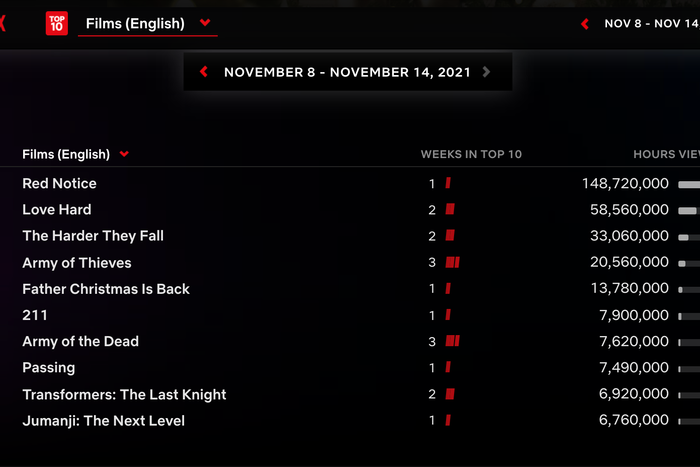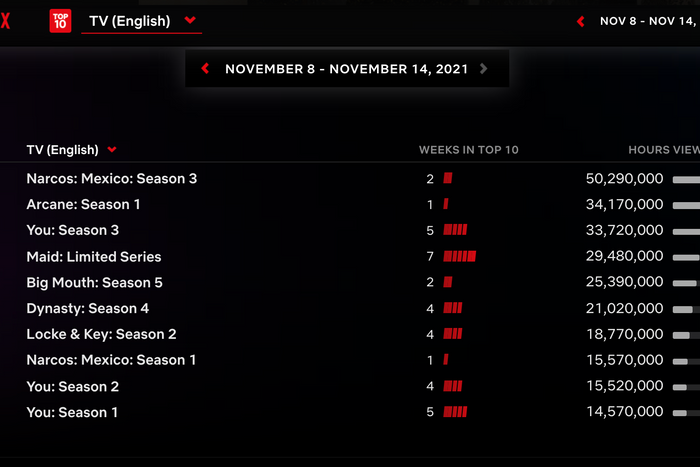
Netflix is making good on its promise to start disclosing viewership stats on a regular basis. Reversing years of secrecy, the streaming giant today will start releasing a weekly report revealing not only the most popular programming on the service but exactly how many viewing hours those titles accumulated around the world over the preceding seven days. Updates are set to be issued every Tuesday — there’s even a spiffy new website — and will feature lists of the ten most-watched TV shows and movies on Netflix, with separate tallies for English-language and non-English programming. Although these new numbers won’t be anywhere near as revealing as the Nielsen ratings used for linear TV, they nonetheless represent a significant development in the battle for streaming-data transparency.
In a new blog post explaining the move, Netflix VP of content strategy, planning, and analysis Pablo Perez De Rosso acknowledged the criticism of the company’s past attempts to offer insights into who’s watching what. “So this summer we went back to the drawing board,” he wrote, framing the commitment to weekly reporting along with the previously announced switch to the hours-viewed metric (earlier, the metric measured how many member homes had streamed at least a couple of minutes of a title) as an attempt to course correct. “People want to understand what success means in a streaming world, and these lists offer the clearest answer to that question in our industry,” De Rosso wrote. What’s more, in a bid to head off critics who have argued that self-reported stats can’t be trusted, the streamer has asked its longtime independent accounting firm, EY (formerly known as Ernst & Young), to audit the new metrics and issue a report sometime next year.
More details about Netflix’s new numbers-reporting regime:
— The top-ten lists will combine original content (Stranger Things, Red Notice) with shows and movies Netflix acquires from other studios (Seinfeld, 21 Jump Street).
— TV shows will be measured by season, making it harder for series with larger back catalogues (Grey’s Anatomy) to crack the lists because they have literally hundreds of hours available for folks to binge. But this will allow analysts to find a surge in viewing for past seasons of a series around the time a new season debuts, so multiple seasons of a series could end up in the top ten for a given week.
— The Netflix lists will measure viewing on a Monday-through-Sunday basis, with the company giving itself a day to process the numbers before posting. This mirrors Nielsen’s decades-old template for issuing weekly ratings reports. Netflix is also rounding its numbers to the nearest 10,000 viewers, much as many networks round up their reported viewing.
— In addition to the global charts, Netflix’s top-ten website will post the most popular movies and TV shows in 90+ countries each week — but those lists won’t break down the hours watched per title in those countries.
— The company will occasionally publish top-ten lists for more specialized content categories (think reality shows, documentaries, and kids’ programming), but there’s no commitment yet to doing so on a regular timetable.
— The metrics website will include weekly reports dating back to the week of June 28, 2021, in case you’re bored and want more specifics on which shows and movies did well last summer.
De Rosso admits the revamped system is unlikely to please those worried about the overall opaqueness of streaming data, including talent agents looking for leverage when negotiating deals for their clients. “There’s no one perfect metric,” the exec wrote in his announcement, admitting, for example, that using hours viewed means shorter movies and shows (such as half-hour comedies) will be at a disadvantage going forward. But “having looked at the different options, we believe engagement as measured by hours viewed is a strong indicator of a title’s popularity, as well as overall member satisfaction, which is important for retention in subscription services,” De Rosso argued. He also pointed to Nielsen’s embrace of time watched (it uses minutes versus hours) as a reason to adopt a similar framework as well as the fact that measuring usage will account for users rewatching shows over and over, a sign of audience satisfaction, he said. It could also help account for password sharing: If two people in different homes use the same Netflix account to watch a movie, that viewership previously counted only once in Netflix’s reported ratings. Now both people will have their viewing tallied.
So what’s in the first publicly released collection of weekly top tens? Per Netflix, the most-watched movie on the platform for the November 8–14 time frame was its much-hyped, megabudget action comedy Red Notice, which accumulated an eye-popping 148.7 million hours of viewing during the first three days of its release. That would put the film just outside the tenth position on Netflix’s list of its top ten movies of all time, which is currently held by the Adam Sandler–Jennifer Aniston opus Murder Mystery (170 million hours in 28 days). It seems all but certain that Red Notice will crack the all-time Netflix top ten in its first week on the platform.
As for TV shows, season three of Narcos: Mexico, which debuted on November 5, ranked as the global leader on Netflix last week with 50.3 million hours of viewing by the streamer’s global membership. It’s followed by the chart debut of the new animated series Arcane (34.2 million) and season three of the drama You (33.7 million). The first two seasons of You also made the top ten, as did the first (but not the second!) season of Narcos: Mexico. As for the red-hot Squid Game, it notched 42.8 million hours of viewership last week, topping the non-English-language TV list (and ranking just behind Narcos: Mexico among all Netflix series). Check out some of the top English-language Netflix programs below:



